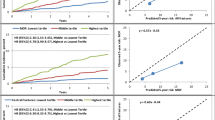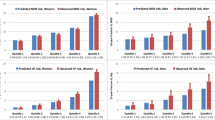Abstract
Summary
The G arvan Fracture Risk Calculator predicts risk of osteoporotic fractures. We evaluated its predictive performance in 16,682 women and 2839 men from Manitoba, Canada, and found significant risk stratification, with a strong gradient across scores. The tool outperformed clinical risk factors and bone mineral density for fracture risk stratification.
Introduction
The optimal model for fracture risk estimation to guide treatment decision-making remains controversial. Our objective was to evaluate the predictive performance of the Garvan Fracture Risk Calculator (FRC) in a large clinical registry from Manitoba, Canada.
Methods
Using the population-based Manitoba Bone Mineral Density (BMD) registry, we identified women and men aged 50–95 years undergoing baseline BMD assessment from September 1, 2012, onwards. Five-year Garvan FRC predictions were generated from clinical risk factors (CRFs) with and without femoral neck BMD. We identified incident non-traumatic osteoporotic fractures (OFs) and hip fractures (HFs) from population-based healthcare data sources to March 31, 2018. Fracture risk was assessed from area under the receiver operating characteristic curve (AUROC). Cox regression analysis and calibration ratios (5-year observed/predicted) were assessed for risk quintiles. All analyses were sex stratified.
Results
We included 16,682 women (mean age 66.6 + / − SD 8.7 years) and 2839 men (mean age 68.7 + / − SD 10.2 years). During a mean observation time of 2.6 years, incident OFs were identified in 681 women and 140 men and HFs in 199 women and 22 men. AUROC showed significant fracture risk stratification with the Garvan FRC. Tool predictions without BMD were better than from age or decreasing weight, and the tool with BMD performed better than BMD alone. Garvan FRC with BMD performed better than without BMD, especially for HF prediction (AUROC 0.86 in women, 0.82 in men). There was a strong gradient of increasing risk across Garvan FRC quintiles (highest versus lowest, hazard ratios women 5.75 and men 3.43 for any OF; women 101.6 for HF). Calibration differences were noted, with both over- and underestimation in risk.
Conclusions
Garvan FRC outperformed CRFs and BMD alone for fracture risk stratification, particularly for HF, but may require recalibration for accurate predictions in this population.


Similar content being viewed by others
References
Compston JE, McClung MR, Leslie WD (2019) Osteoporosis. Lancet 393(10169):364–376
Kanis JA, Harvey NC, Cooper C, Johansson H, Oden A, McCloskey EV et al (2016) A systematic review of intervention thresholds based on FRAX: a report prepared for the National Osteoporosis Guideline Group and the International Osteoporosis Foundation. Arch Osteoporos 11(1):25
Rubin KH, Friis-Holmberg T, Hermann AP, Abrahamsen B, Brixen K (2013) Risk assessment tools to identify women with increased risk of osteoporotic fracture: complexity or simplicity? A systematic review. J Bone Miner Res 28(8):1701–1717
Beaudoin C, Moore L, Gagne M, Bessette L, Ste-Marie LG, Brown JP et al (2019) Performance of predictive tools to identify individuals at risk of non-traumatic fracture: a systematic review, meta-analysis, and meta-regression. Osteoporos Int 30(4):721–740
Nguyen ND, Frost SA, Center JR, Eisman JA, Nguyen TV (2008) Development of prognostic nomograms for individualizing 5-year and 10-year fracture risks. Osteoporos Int 19(10):1431–1444
Nguyen ND, Frost SA, Center JR, Eisman JA, Nguyen TV (2007) Development of a nomogram for individualizing hip fracture risk in men and women. Osteoporos Int 18(8):1109–1117
Baleanu F, Iconaru L, Charles A, Kinnard V, Fils JF, Moreau M et al (2021) Independent external validation of FRAX and Garvan fracture risk calculators: a sub-study of the FRISBEE cohort. JBMR Plus. 5(9):e10532
Dagan N, Cohen-Stavi C, Leventer-Roberts M, Balicer RD (2017) External validation and comparison of three prediction tools for risk of osteoporotic fractures using data from population based electronic health records: retrospective cohort study. BMJ 356:i6755
Ahmed LA, Nguyen ND, Bjørnerem Å, Joakimsen RM, Jørgensen L, Størmer J et al (2014) External validation of the Garvan nomograms for predicting absolute fracture risk: the Tromsø study. PLoS One. 9(9):e107695
Langsetmo L, Nguyen TV, Nguyen ND, Kovacs CS, Prior JC, Center JR et al (2011) Independent external validation of nomograms for predicting risk of low-trauma fracture and hip fracture. CMAJ 183(2):E107–E114
Lix LM, Azimaee M, Osman BA, Caetano P, Morin S, Metge C et al (2012) Osteoporosis-related fracture case definitions for population-based administrative data. BMC Public Health 12:301
Leslie WD, Morin SN, Lix LM, Niraula S, McCloskey EV, Johansson H et al (2019) Performance of FRAX in women with breast cancer initiating aromatase inhibitor therapy: a registry-based cohort study. J Bone Miner Res 34(8):1428–1435
Peschken CA, Hitchon CA, Garland A, Bernstein CN, Chen H, Fransoo R et al (2016) A population-based study of intensive care unit admissions in rheumatoid arthritis. J Rheumatol 43(1):26–33
Yang S, Leslie WD, Yan L, Walld R, Roos LL, Morin SN et al (2016) Objectively verified parental hip fracture is an independent risk factor for fracture: a linkage analysis of 478,792 parents and 261,705 offspring. J Bone Miner Res 31(9):1753–1759
O’donnell S, Group CCDSSCOW. Use of administrative data for national surveillance of osteoporosis and related fractures in Canada: results from a feasibility study. Arch Osteoporos. 2013;8:143.
Leslie WD, Epp R, Morin SN, Lix LM (2021) Assessment of site-specific X-ray procedure codes for fracture ascertainment: a registry-based cohort study. Arch Osteoporos 16(1):107
Hanley JA, McNeil BJ (1983) A method of comparing the areas under receiver operating characteristic curves derived from the same cases. Radiology 148(3):839–843
Organization WH. Assessment of fracture risk and its application to screening postmenopausal osteoporosis. Technical Report series 843. Geneva; 1994.
Leslie WD, Caetano PA, Macwilliam LR, Finlayson GS (2005) Construction and validation of a population-based bone densitometry database. J Clin Densitom 8(1):25–30
Steyerberg EW (2008) Clinical prediction models: a practical approach to development, validation, and updating. Springer, New York
Acknowledgements
The authors acknowledge the Manitoba Centre for Health Policy for use of data contained in the Population Health Research Data Repository (HIPC 2016/2017-29). The results and conclusions are those of the authors and no official endorsement by the Manitoba Centre for Health Policy, Manitoba Health, Seniors and Active Living or other data providers is intended or should be inferred. SNM is chercheur-boursier des Fonds de Recherche du Québec en Santé. LML is supported by a Tier I Canada Research Chair. This article has been reviewed and approved by the members of the Manitoba Bone Density Program Committee.
Author information
Authors and Affiliations
Corresponding author
Ethics declarations
Ethics approval
The study was approved by the Health Research Ethics Board for the University of Manitoba.
Conflict of interest
AA Agarwal, WD Leslie, LM Lix and SN Morin declare they have no conflict of interest. JA Eisman has consulted for and/or received research funding from Amgen, deCode, Merck Sharp and Dohme and Sanofi-Aventis. TV Nguyen has received honoraria for consulting and symposia from Merck Sharp and Dohme, Roche, Servier, Sanofi-Aventis and Novartis.
Additional information
Publisher's Note
Springer Nature remains neutral with regard to jurisdictional claims in published maps and institutional affiliations.
Supplementary Information
Below is the link to the electronic supplementary material.
Rights and permissions
About this article
Cite this article
Agarwal, A., Leslie, W.D., Nguyen, T.V. et al. Predictive performance of the Garvan Fracture Risk Calculator: a registry-based cohort study. Osteoporos Int 33, 541–548 (2022). https://doi.org/10.1007/s00198-021-06252-3
Received:
Accepted:
Published:
Issue Date:
DOI: https://doi.org/10.1007/s00198-021-06252-3




